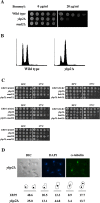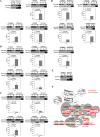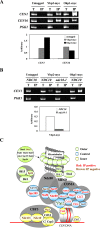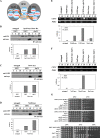Ybp2 associates with the central kinetochore of Saccharomyces cerevisiae and mediates proper mitotic progression
- PMID: 18286174
- PMCID: PMC2238814
- DOI: 10.1371/journal.pone.0001617
Ybp2 associates with the central kinetochore of Saccharomyces cerevisiae and mediates proper mitotic progression
Abstract
The spindle checkpoint ensures the accurate segregation of chromosomes by monitoring the status of kinetochore attachment to microtubules. Simultaneous mutations in one of several kinetochore and cohesion genes and a spindle checkpoint gene cause a synthetic-lethal or synthetic-sick phenotype. A synthetic genetic array (SGA) analysis using a mad2Delta query mutant strain of yeast identified YBP2, a gene whose product shares sequence similarity with the product of YBP1, which is required for H(2)O(2)-induced oxidation of the transcription factor Yap1. ybp2Delta was sensitive to benomyl and accumulated at the mitotic stage of the cell cycle. Ybp2 physically associates with proteins of the COMA complex (Ctf19, Okp1, Mcm21, and Ame1) and 3 components of the Ndc80 complex (Ndc80, Nuf2, and Spc25 but not Spc24) in the central kinetochore and with Cse4 (the centromeric histone and CENP-A homolog). Chromatin-immunoprecipitation analyses revealed that Ybp2 associates specifically with CEN DNA. Furthermore, ybp2Delta showed synthetic-sick interactions with mutants of the genes that encode the COMA complex components. Ybp2 seems to be part of a macromolecular kinetochore complex and appears to contribute to the proper associations among the central kinetochore subcomplexes and the kinetochore-specific nucleosome.
Conflict of interest statement
Figures





Similar articles
-
The kinetochore module Okp1CENP-Q/Ame1CENP-U is a reader for N-terminal modifications on the centromeric histone Cse4CENP-A.EMBO J. 2019 Jan 3;38(1):e98991. doi: 10.15252/embj.201898991. Epub 2018 Nov 2. EMBO J. 2019. PMID: 30389668 Free PMC article.
-
Molecular basis for inner kinetochore configuration through RWD domain-peptide interactions.EMBO J. 2017 Dec 1;36(23):3458-3482. doi: 10.15252/embj.201796636. Epub 2017 Oct 18. EMBO J. 2017. PMID: 29046335 Free PMC article.
-
A 3D map of the yeast kinetochore reveals the presence of core and accessory centromere-specific histone.Curr Biol. 2013 Oct 7;23(19):1939-44. doi: 10.1016/j.cub.2013.07.083. Epub 2013 Sep 26. Curr Biol. 2013. PMID: 24076245 Free PMC article.
-
The Ndc80 complex: hub of kinetochore activity.FEBS Lett. 2007 Jun 19;581(15):2862-9. doi: 10.1016/j.febslet.2007.05.012. Epub 2007 May 11. FEBS Lett. 2007. PMID: 17521635 Review.
-
The composition, functions, and regulation of the budding yeast kinetochore.Genetics. 2013 Aug;194(4):817-46. doi: 10.1534/genetics.112.145276. Genetics. 2013. PMID: 23908374 Free PMC article. Review.
Cited by
-
Degradation of centromeric histone H3 variant Cse4 requires the Fpr3 peptidyl-prolyl Cis-Trans isomerase.Genetics. 2014 Apr;196(4):1041-5. doi: 10.1534/genetics.114.161224. Epub 2014 Feb 10. Genetics. 2014. PMID: 24514906 Free PMC article.
-
Conserved Tetramer Junction in the Kinetochore Ndc80 Complex.Cell Rep. 2016 Nov 15;17(8):1915-1922. doi: 10.1016/j.celrep.2016.10.065. Cell Rep. 2016. PMID: 27851957 Free PMC article.
-
Suppressors of ipl1-2 in components of a Glc7 phosphatase complex, Cdc48 AAA ATPase, TORC1, and the kinetochore.G3 (Bethesda). 2012 Dec;2(12):1687-701. doi: 10.1534/g3.112.003814. Epub 2012 Dec 1. G3 (Bethesda). 2012. PMID: 23275890 Free PMC article.
-
SUMO-Targeted Ubiquitin Ligase (STUbL) Slx5 regulates proteolysis of centromeric histone H3 variant Cse4 and prevents its mislocalization to euchromatin.Mol Biol Cell. 2016 Mar 9;27(9):1500-10. doi: 10.1091/mbc.E15-12-0827. Online ahead of print. Mol Biol Cell. 2016. PMID: 26960795 Free PMC article.
-
Ybp1 and Gpx3 signaling in Candida albicans govern hydrogen peroxide-induced oxidation of the Cap1 transcription factor and macrophage escape.Antioxid Redox Signal. 2013 Dec 20;19(18):2244-60. doi: 10.1089/ars.2013.5199. Epub 2013 Jul 9. Antioxid Redox Signal. 2013. PMID: 23706023 Free PMC article.
References
-
- Biggins S, Walczak CE. Captivating capture: how microtubules attach to kinetochores. Curr Biol. 2003;13:R449–460. - PubMed
-
- Kitagawa K, Hieter P. Evolutionary conservation between budding yeast and human kinetochores. Nat Rev Mol Cell Biol. 2001;2:678–687. - PubMed
-
- Goshima G, Yanagida M. Establishing biorientation occurs with precocious separation of the sister kinetochores, but not the arms, in the early spindle of budding yeast. Cell. 2000;100:619–633. - PubMed
-
- He X, Asthana S, Sorger PK. Transient sister chromatid separation and elastic deformation of chromosomes during mitosis in budding yeast. Cell. 2000;101:763–775. - PubMed
Publication types
MeSH terms
Substances
Grants and funding
LinkOut - more resources
Full Text Sources
Molecular Biology Databases

